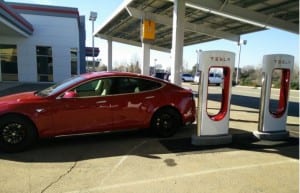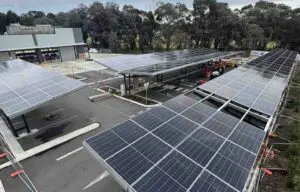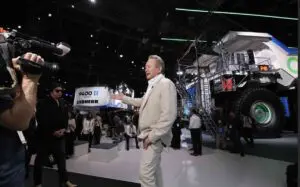
A high-powered, industry-based effort to bring Australia up to speed on electric vehicles, by building its first nationally coordinated EV fast charging network, is set to be realised, after receiving a major funding boost this week.
The plan to build the national electric vehicle highway is being led by Fast Cities Australia and is closely linked to the deep pockets of Rich Lister and energy entrepreneur Trevor St Baker.
Fast Cities said on Friday that it had secured a $7 million investment from St Baker’s Energy Innovation Fund – allowing work to begin on the project, which it believes will give Australian EV drivers, fleet owners and manufacturers the confidence to go electric.
“We’re in roll-out phase,” Fast Cities Australia CEO Chris Mills told RenewEconomy on Friday – starting with what he calls a “legitimate backbone” of 42 sites, each with a minimum of two 350kW fast chargers.
“That all adds up to about $1 million a site,” adds Mills. “So that initial investment (of $7 million), that gets us going. It allows us to issue out all of the instructions to our consultants, to find candidates for sites, to look into compliance, connectivity…”
The Fast Cities Australia initiative – and the vehicle to drive it – was first hatched almost four years ago, initially in partnership with Tritium, just after the latter company had signed a deal to have its world-leading Veefil DC fast chargers installed across three countries in Europe.
Since that time, Tritium has not looked back, landing more and more deals across Europe, setting up a base in Amsterdam, and ramping up the production capabilities of its Brisbane manufacturing base, to meet the booming demand.
And its technology has continued to evolve, too: its High Power Chargers, offer EV drivers 150km of range in just 5 minutes – almost as fast as filling up a petrol tank.
As we reported here, it was for these HPCs that the company signed a huge deal at the start of the month with Munich-based IONITY – a joint venture with BMW Group, Daimler, Ford and the Volkswagen Group – to supply a network of around 400 charging stations with up to six HPC units for 100 sites being built across Germany, France, UK, Norway and Sweden.
But while all this has been going on overseas, in Australia it has been a different story – thanks largely to a dearth of supporting policy or industry support.
And that’s where Fast Cities comes in – although these days it has no official affiliation with Tritium, beyond plans to use its technology.
The outfit – off the back of seed funding of $0.5 million, also from St Baker’s Energy Innovation Fund (St Baker is also Fast Cities’ chairman) – has for the past 12 months been busy selecting, designing and planning sites for the nation-wide infrastructure.
Now, it has enough working capital to begin work in earnest on the $100 million infrastructure project, which both Mills and Fast Cities co-founder Paul Fox so passionately believe will be critical to driving Australian EV uptake.
The first step of the plan is to have the first 16 sites – which will span between Brisbane and Melbourne – installed by the end of 2019, with the balance of the 42 to be completed by the end of 2021.
Mills says the initially rollout amount of 42 was settled on based on the theory that it would put the fast charging sites within around 150km of each other.
Any fewer sites would not be properly “national”, and would only cater to the prestige end of the EV market, whose cars have bigger batteries than can travel further on one charge.
“That first 42 sites is what we call the national backbone,” Mills told RE. “We would intend to then flesh out further sites.
“Our genuine aim is to catalyse the industry… to increase the uptake of EVs in the country.
“If you look at the next key ingredient (to this), you need to apply 350kW charging units. Anything smaller or slower adds a unacceptable delay to your travel time.
“People who drive for three hours don’t want to have to wait 70 minutes or more to charge their car up again. …That’s ok for destination charging, but not for en route. Then you want it to be 10-15 minutes, at most, where you can take a rest break, grab a coffee and the like.”
And Fox adds that this calibre of fast charger is also crucial to converting the commercial market to electric vehicles – he points to ABS statistics showing that almost one-quarter of all commercial vehicles kilometres travelled are on extended trips.
“If you’re serious about attracting the commercial market, they’re not going to tolerate waiting an hour to charge,” Fox said.
Of course, $7 million is just a small portion of the estimated $100 million Fast Cities’ believe it will take to build a 100 site network.
But the team is confident that as market momentum builds, and all parties awaken to the benefits of EVs – consumers, networks, the auto industry, government – this network will catalyse further investment.
“What we see now is a lack of confidence in the market to buy or import EVs,” Fox told RE. “We actually believe that (this project) will provide that confidence, give confidence to that market. It will have a catalytic effect, getting out there, getting that thing built.
“Someone has to be the pioneer for this.”
Should the government be helping to pave the way?
“For us, there’s obviously things we would like to see, network tariffs, planning processes and procedures, that would make it easier to deploy fast charging in Australia,” Fox says.
And government funding would probably not be sneezed at, either – as Fox notes, there’s a strong case for spending on boosting EV uptake, not least for emissions reduction.
But Fox says that a great deal of the work that needs to be done is simply around awareness.
“Drivers need to know that electric vehicles are coming; they should be thinking now that their next car will be an EV.
“All these cars are on their way and they’re fun vehicles to drive. (Consumers) just need to have the confidence of knowing they can do it.”










